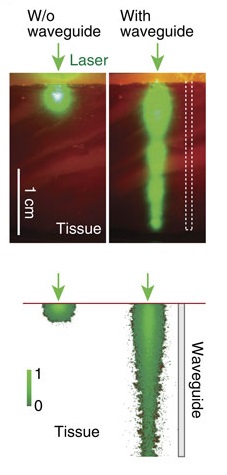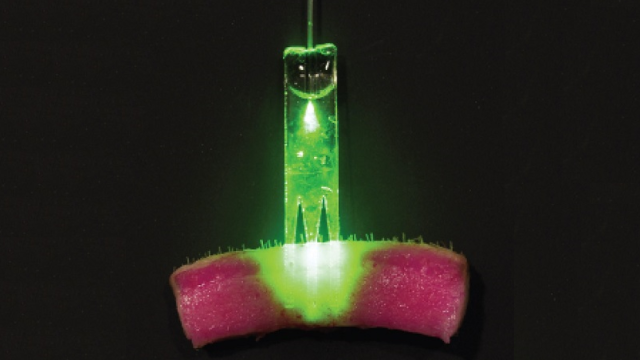A certain medical dye will stick together when hit by a laser, effectively suturing a wound without the need for staples or traditional sutures. But the dye will only penetrate as deep as the light does, so this method only works on superficial wounds. The solution is a biological wave guide to direct the light deeper into the wound.
You’ve probably seen rose bengal dye in your optometrist’s office. It’s rather old-fashioned, and falling out of favour, but scientists have found other uses for it. When it’s hit by a laser, the dye can form sutures that close a wound — as long as it’s not too deep. Scientists from University of St Andrews and Harvard Medical School have introduced a wave guide that will focus laser light down into deep wounds, and then gradually degrade away. They just published their findings in Nature Communications.

Rose bengal dye is used in a technique called “nano-suturing“. Collagen is a protein that gives skin its structure. When it’s missing an electron, one collagen molecule will bond with the collagen molecule next to it. The light causes the dye to snatch an electron from the collagen, causing it to become a free radical. Free radicals are missing an outer electron, and will bind with other atoms nearby to acquire that electron. In this case, the collagen binds with other collagen in the skin, knitting the wound back together, which is exactly what doctors want when suturing a wound.
Unlike physical sutures, nano-suturing cuts down on scars and inflammation. Up until now, though, it’s necessarily been a superficial procedure.
The new waveguide looks like a little piece of plastic with a forked edge. The clear plastic guides the light into the wound, exposing deep cuts to the dye. Other wave guides haven’t been practical because they eventually had to be removed. This one is made of a biodegradable polymer. It can be left in the wound, where it will eventually break down and be eliminated by the body.
The researchers tested the wave guide by suturing a 10mm deep wound on pig skin. They hope that this will lead to so-called “photomedicine” being used to regularly heal deeper wounds.
[Nature Communications via Medgadget]
Top Image: St. Andrews University Second Image: Nature Communications
